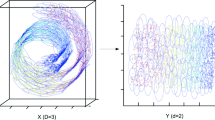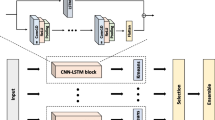Abstract
Sentiment time series is an effective tool to describe the trend of users’ emotions towards specific topics over time. Most existing studies generate time series based on predicted results of the sentiment classifiers, which may not correspond to the actual values due to the lack of labeled data or the limited performance of the classifier. To alleviate this problem, we propose a calibrated-based method to generate time series composed of accurate sentiment scores. The texts are embedded into high dimensional representations with a feature extractor and then get fine-tuned and compressed into lower dimensional space with the unsupervised learning of an autoencoder. Then a deep clustering method is applied to partition the data into different clusters. A group of representative samples are selected according to their distance from the clustering centers. Finally combined the evaluation results on the sampled data and the predicted results, the calibrated sentiment score is obtained. We build a real-world dataset crawled from Sina Weibo and perform experiments on it. We compare the distance errors of predicted-based method with our calibrated-based method. The experimental results indicate that our method reduces the uncertainty raised by sampling as well as maintains excellent performance.
Access this chapter
Tax calculation will be finalised at checkout
Purchases are for personal use only
Similar content being viewed by others
References
An, X., Ganguly, A.R., Fang, Y., Scyphers, S.B., Hunter, A.M., Dy, J.G.: Tracking climate change opinions from twitter data. In: Workshop on Data Science for Social Good (2014)
Barbosa, L., Feng, J.: Robust sentiment detection on twitter from biased and noisy data. In: Proceedings of the 23rd International Conference on Computational Linguistics: Posters, pp. 36–44. COLING ’10, Association for Computational Linguistics, USA (2010)
Daniel, M., Neves, R.F., Horta, N.: Company event popularity for financial markets using twitter and sentiment analysis. Expert Syst. Appl. 71, 111–124 (2017). https://doi.org/10.1016/j.eswa.2016.11.022
Devlin, J., Chang, M.W., Lee, K., Toutanova, K.: BERT: pre-training of deep bidirectional transformers for language understanding. In: Proceedings of the 2019 Conference of the North American Chapter of the Association for Computational Linguistics: Human Language Technologies, Volume 1 (Long and Short Papers), pp. 4171–4186. Association for Computational Linguistics, Minneapolis, Minnesota (2019). https://doi.org/10.18653/v1/N19-1423
Ghiassi, M., Zimbra, D., Lee, S.: Targeted twitter sentiment analysis for brands using supervised feature engineering and the dynamic architecture for artificial neural networks. J. Manag. Inform. Syst. 33, 1034–1058 (2016). https://doi.org/10.1080/07421222.2016.1267526
Giachanou, A., Crestani, F.: Tracking sentiment by time series analysis. In: Proceedings of the 39th International ACM SIGIR Conference on Research and Development in Information Retrieval, pp. 1037–1040. SIGIR ’16, Association for Computing Machinery, New York, NY, USA (2016). https://doi.org/10.1145/2911451.2914702
Guo, X., Gao, L., Liu, X., Yin, J.: Improved deep embedded clustering with local structure preservation. In: Proceedings of the Twenty-Sixth International Joint Conference on Artificial Intelligence, IJCAI-17, pp. 1753–1759 (2017). https://doi.org/10.24963/ijcai.2017/243
Ibrahim, N.F., Wang, X.: Decoding the sentiment dynamics of online retailing customers: time series analysis of social media. Comput. Hum. Behav. 96, 32–45 (2019). https://doi.org/10.1016/j.chb.2019.02.004
Kalchbrenner, N., Grefenstette, E., Blunsom, P.: A convolutional neural network for modelling sentences. In: 52nd Annual Meeting of the Association for Computational Linguistics, ACL 2014 - Proceedings of the Conference, vol. 1 (2014). https://doi.org/10.3115/v1/P14-1062
Kim, Y.: Convolutional neural networks for sentence classification. In: Proceedings of the 2014 Conference on Empirical Methods in Natural Language Processing (2014). https://doi.org/10.3115/v1/D14-1181
Kingma, D.P., Ba, J.: Adam: a method for stochastic optimization. In: Bengio, Y., LeCun, Y. (eds.) 3rd International Conference on Learning Representations, ICLR 2015, San Diego, CA, USA, May 7–9, 2015, Conference Track Proceedings (2015)
Lansdall-Welfare, T., Dzogang, F., Cristianini, N.: Change-point analysis of the public mood in uk twitter during the brexit referendum. In: 2016 IEEE 16th International Conference on Data Mining Workshops (ICDMW), pp. 434–439 (2016)
Li, L., Wu, Y., Zhang, Y., Zhao, T.: Time+user dual attention based sentiment prediction for multiple social network texts with time series. IEEE Access 7, 17644–17653 (2019). https://doi.org/10.1109/ACCESS.2019.2895897
Moradi Fard, M., Thonet, T., Gaussier, E.: Deep k-means: jointly clustering with k-means and learning representations. Pattern Recogn. Lett. 138, 185–192 (2020). https://doi.org/10.1016/j.patrec.2020.07.028
Pang, B., Lee, L., Vaithyanathan, S.: Thumbs up? sentiment classification using machine learning techniques. In: Proceedings of the ACL-02 Conference on Empirical Methods in Natural Language Processing, vol. 10, pp. 79–86. EMNLP ’02, Association for Computational Linguistics, USA (2002). https://doi.org/10.3115/1118693.1118704
Wang, X., Liu, Y., Sun, C., Wang, B., Wang, X.: Predicting polarities of tweets by composing word embeddings with long short-term memory. In: Proceedings of the 53rd Annual Meeting of the Association for Computational Linguistics and the 7th International Joint Conference on Natural Language Processing (Volume 1: Long Papers), pp. 1343–1353. Association for Computational Linguistics, Beijing, China (2015). https://doi.org/10.3115/v1/P15-1130
Xie, J., Girshick, R., Farhadi, A.: Unsupervised deep embedding for clustering analysis. In: International Conference on Machine Learning, pp. 478–487. PMLR (2016)
Zhou, P., Qi, Z., Zheng, S., Xu, J., Bao, H., Xu, B.: Text classification improved by integrating bidirectional LSTM with two-dimensional max pooling. In: Proceedings of COLING 2016, the 26th International Conference on Computational Linguistics: Technical Papers, pp. 3485–3495. The COLING 2016 Organizing Committee, Osaka, Japan (2016)
Zou, H., Tang, X., Xie, B., Liu, B.: Sentiment classification using machine learning techniques with syntax features. In: Proceedings of the 2015 International Conference on Computational Science and Computational Intelligence (CSCI), pp. 175–179. CSCI ’15, IEEE Computer Society, USA (2015). https://doi.org/10.1109/CSCI.2015.44
Acknowledgments
This work is supported by the National Natural Science Foundation of China (No. 51975294).
Author information
Authors and Affiliations
Corresponding author
Editor information
Editors and Affiliations
Rights and permissions
Copyright information
© 2021 Springer Nature Switzerland AG
About this paper
Cite this paper
Wu, J., Qiu, B., Shang, L. (2021). A Calibration Method for Sentiment Time Series by Deep Clustering. In: Pham, D.N., Theeramunkong, T., Governatori, G., Liu, F. (eds) PRICAI 2021: Trends in Artificial Intelligence. PRICAI 2021. Lecture Notes in Computer Science(), vol 13032. Springer, Cham. https://doi.org/10.1007/978-3-030-89363-7_1
Download citation
DOI: https://doi.org/10.1007/978-3-030-89363-7_1
Published:
Publisher Name: Springer, Cham
Print ISBN: 978-3-030-89362-0
Online ISBN: 978-3-030-89363-7
eBook Packages: Computer ScienceComputer Science (R0)




